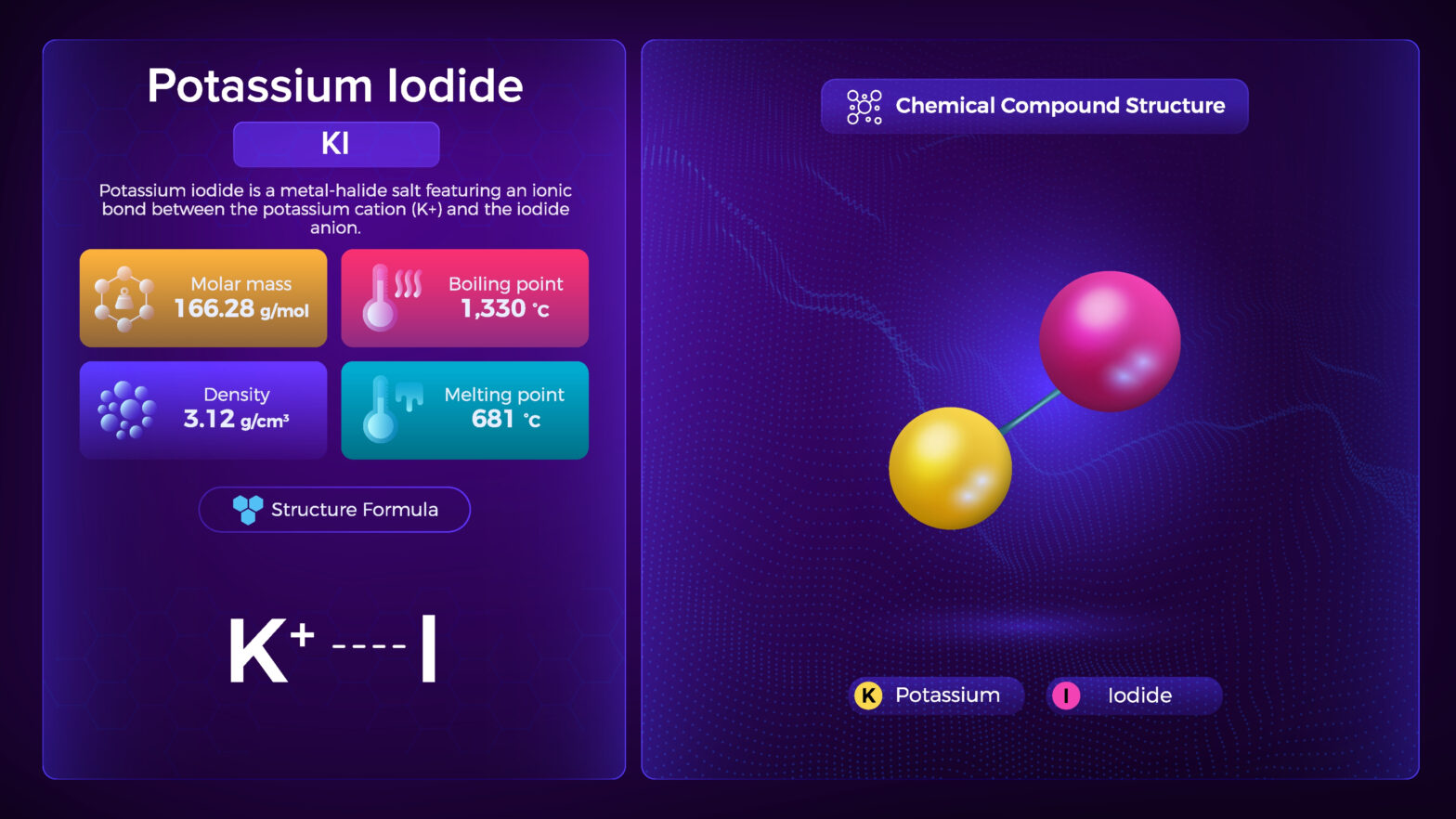INTRODUCTION
Potassium iodide is an inorganic chemical compound which is denoted by the chemical formula KI. It is a metal-halide salt featuring an ionic bond between the potassium cation (K+) and the iodide anion (I–). It is colourless to white, it appears as powder or white granules. It has a highly bitter, saline taste.
It is an essential iodide source in several organic synthesis reactions. It has a variety of applications in coatings, animal feed, life sciences, pigments, polymer additives, and process chemicals. Having reactive properties, iodide can be a part of many oxidising reactions, as well as create stable ionic complexes with carbon. Iodine ions play a significant role in regulating human growth hormones.
Manufacture
Commercially it is made by mixing potassium hydroxide with iodine.
| CAS no. | 7681-11-0 |
| EINECS no. | 213-659-4 |
| Molecular formula | IK |
| Molecular weight | 166 |
| Structure | KI |
Applications
KI is a versatile compound that is used in a variety of industries
| Animal Nutrition | To address the Iodine deficiency to fulfil the nutrition needs of the Animals. Helps optimize nutrition, improve gut health, support immune function, improve the absorption of nutrients that help in extending the shelf life of feed, and reducing harmful pathogens in the feed and water animals consume. |
| Electronics | It is used as a polarizing agent in LCD and LED screens manufacturing. |
| Expectorant | It is used as an expectorant for those who suffer from chronic breathing disorders like asthma, bronchitis and emphysema. |
| Human Nutrition | Iodine is an essential element for human growth and development. Potassium Iodide is used in the manufacturing of dietary supplements for children and adults. |
| Lab Chemicals | Potassium Iodide is used in the laboratory as reagents, extraction agents and additives for various chemistry and biochemistry analysis. |
| Oil and Gas | It is used for corrosion inhibition and leak detection in upstream oil and gas production. |
| Polymer | Potassium Iodide is used as heat stabilizing agents in the manufacture of Nylon tire cord. Its main use is the manufacture of tires, where the heat resistance of the polymer is essential. |
SPECIFICATIONS
| Test | Unit | Specification |
|---|---|---|
| Appearance | – | White crystalline powder |
| Odour | – | Odourless |
| Assay (on dry basis) | % | Min 99.0 |
STORAGE
Store at ambient conditions in closed containers away from heat and moisture.
PACKING
25 kg Fiber / HDPE Drum.
CERTIFICATION
FAMI-QS, Halal & Kosher.
REACH Status
KI offered by ExSyn is registered under EU REACH regulations.
ExSyn offers KI on commercial scales and welcomes enquiries. No matter the quantity you need, our exceptional quality and service will make ExSyn your supplier of choice! If you need any additional information or SDS, please contact us.
5-Methyl-3-vinyl-2-oxazolidinone (V-MOX) is a highly reactive monomer valued for its low viscosity, mild odor, and excellent reactivity. It is widely used as a reactive diluent in UV-curable inks and coatings, where it enhances adhesion, produces brighter colors, and improves safety compared to conventional diluents. In addition, V-MOX serves as a key building block in the synthesis of kinetic hydrate inhibitor (KHI) polymers, which are applied in oil and gas production to prevent hydrate blockages in pipelines.
Zinc ricinoleate is the zinc salt of ricinoleic acid, a hydroxylated fatty acid derived mainly from castor oil (Ricinus communis). It appears as a white to slightly yellowish powder, waxy solid, or paste, depending on formulation. Its most valuable property is its ability to trap and absorb odor molecules such as amines, sulfides, and short-chain fatty acids, making it an essential ingredient in deodorant and odor-control products.
2-(tert-Butyl amino)ethyl methacrylate (TBAEMA) is a functional methacrylate monomer that contains a secondary amine group and a hydrophobic tert-butyl moiety, giving it excellent versatility in pH-responsive and adhesion-enhancing polymer systems.
It is valued in printing ink formulations for its ability to enhance adhesion, flexibility, and surface interaction.
Commonly known as potassium bis(fluorosulfonyl)imide (KFSI), the compound has a three-carbon backbone bearing six fluorine atoms and two sulfonimide (-SO₂F) groups. The molecule’s architecture lends it both high chemical stability and useful reactivity. Because of its excellent ionic conductivity and thermal / electrochemical stability, it finds use in advanced electrolyte formulations—for example in lithium-ion and next-generation batteries, in ionic liquids, and in other electrochemical systems.
Colchicine is a naturally occurring alkaloid obtained primarily from the autumn crocus (Colchicum autumnale) and related species. It has been used in medicine for centuries, especially for the treatment of gout and Familial Mediterranean Fever. In modern medicine, Colchicine is valued also in conditions like pericarditis, Behçet’s disease, and certain dermatological and cardiac disorders.
1-Butylimidazole is a versatile organic heterocyclic compound belonging to the imidazole family, where a butyl group (–CH₂–CH₂–CH₂–CH₃) is attached to the nitrogen atom at the 1-position of the imidazole ring. Its applications span organic synthesis, materials science, and bioactive compound development due to its tunable physicochemical properties and structural versatility.
Atropine sulfate monohydrate is a chemical compound, specifically a salt of atropine and sulfuric acid, with one water molecule (monohydrate) attached. It is commonly used as a medication and in research due to its anticholinergic properties, meaning it blocks the effects of acetylcholine at muscarinic receptors.
4-Aminobenzoic acid, commonly abbreviated as PABA, is an aromatic amine and carboxylic acid compound. It consists of a benzene ring substituted with an amino group (–NH₂) in the para position to a carboxylic acid group (–COOH).
2-Amino-5-Nitrophenol (5-NAP) is an organic compound with the molecular formula C₆H₆N₂O₃. It is a substituted phenol with both an amino group (-NH₂) and a nitro group (-NO₂) attached to a benzene ring, along with a hydroxyl group (-OH).
